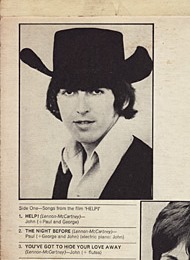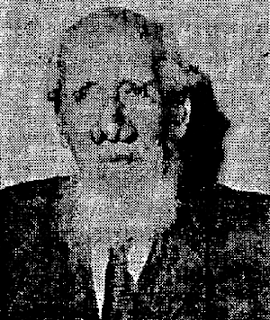A TALENT FOR LOVING: THE BEATLES COWBOY MOVIE THAT NEVER WAS
In 2009, a script for A Talent for Loving was auctioned at Bonhams. It was a treatment for a movie and was signed by all four Beatles. It apparently sold for a little under £8,000. I hadn’t heard of this movie before and was curious. What was it and why was it signed by the Beatles?
It was adapted for the screen by Evelyn and Richard Condon, from Richard Condon’s 1961 offbeat novel of the same name. According to Wikipedia, A Talent for Loving tells the tale of a sixteenth-century Aztec priest who cut off his own hand and used the bloody stump to lay a curse upon a blasphemous Spanish conquistador and all his direct descendants. Three centuries on, in 1871, the beautiful young virginal daughter of a fabulously wealthy Texas rancher and gambler is its latest victim. The action centres around a cowboy race, run to decide who would win her hand in marriage.
It didn’t sound very Beatle-ish. I dug into the archives.
Brian Epstein must have detected the potential in the story for character development beyond the ‘Beatles as themselves’ roles they had portrayed in 1964’s A Hard Day’s Night. Rather than playing themselves, it was reported, the Fab Four wanted to develop in a third movie ‘the parts that they play in their next film [Help!] so they are different to anything they’ve done before’.
More pertinently, the Fab Four loved cowboys – Ringo especially. All four had grown up with cowboy films and TV shows. They had even been photographed on horseback in cowboy hats the previous September, when they took a day off from their hectic schedule to visit Reed Pigman’s ranch in Alton, Missouri.
 |
| At Reed Pigman’s ranch in Alton, Missouri, 19 September 1964. Photographs by Curt Gunther |
If Ringo was the primary enthusiast for the movie project, George Harrison, at least, had apparently read Condon’s novel. It was ‘a good book – a Western, but different to others,’ he reckoned. Epstein duly acquired the rights to A Talent for Loving before the Beatles flew off to the Bahamas in February 1965, to shoot sequences for what would become Help!.
Meanwhile the NME and Stage magazine both reported that, never mind the hotly-anticipated second movie, the author Richard Condon was in his Geneva home, busily adapting A Talent for Loving for a third Beatles movie. Condon was naturally delighted with the project: ‘No reason why Liverpool lads should not be out there, complete with accents, lariats and six-shooters,’ he told the Sunday Mirror.
The picture was to be made in England and Spain and time was allotted in the Beatles’ busy schedule for the autumn of 1965. Production would be by Pickfair Films Limited, a company formed by Brian Epstein with former United Artists exec Bud Ornstein (later to be Beatle sideman Neil Aspinall’s father-in-law). The leading lady was still to be cast and no director had yet been assigned.
It was uncertain at this early stage whether this project would satisfy the three-picture deal Epstein had agreed with United Artists.
By the summer, however, Walter Shenson, the Hollywood agent who negotiated the Beatle film deals, was clear: ‘We are contracted for a third picture. It will probably be A Talent for Loving, a novel of Richard Condon which the Beatles own. It’s a Western, set on the California-Mexico border 100 years ago.’
Summer came and went, with the release of the Help! movie, soundtrack and attendant single, and a short North American tour. When ‘the boys’ were asked about the next Beatles film, just as they were preparing to fly to the United States, the reply was that they hadn’t had much chance to go over the script for A Talent for Loving but that plans were already in hand for the location work, which was to take place in either Spain or Mexico.
When they returned from the ’65 US/Canadian tour, it was clear that work on the movie would not be underway before Christmas. October and November were taken up recording and mixing their next LP, Rubber Soul, for December release. ‘We should have started our third film, which was to be a cowboy epic,’ commented Lennon. Mexico was now impossible. ‘The nearest location for the outdoor scenes was Spain, but it got so late in the year we couldn’t risk the weather, so it was postponed ’til the spring, which left us with just enough time before Christmas to play the dates that were lined up.’
But Lennon’s comment that it was the weather to blame concealed the disharmony that had stifled progress on the movie. He’d earlier let slip his doubts at a press conference, commenting that he and Paul would not be able to write a song with a title like ‘A Talent for Loving’: although of course the title could always have been changed for a Beatle movie, as had happened with Help! (whose working title had been ‘Eight Arms to Hold You’, a phrase Lennon and McCartney found too hard to write around).
It was apparent that not all four Beatles were fully on board with the cowboy script. With two films under their belt, they were becoming more aware of what was involved in film-making and what sort of result they wanted to see on screen. November’s Beatles Book reported that Paul, George and John were ‘not too happy with certain parts’ of the screenplay for A Talent for Loving – which the fan mag mistakenly referred to as ‘A Kind of Loving’ (confusing the title with that of Stan Barstow’s kitchen-sink novel, which had been adapted for the big screen three years earlier).
The NME confirmed that plans for filming in the autumn were cancelled. But all was not lost. As the Liverpool Echo, put it, ‘next spring they are going before the cameras again, in Spain’. The newspaper also assured fans that Lennon and McCartney would be providing the musical score.
Apart from the Beatles themselves the only other star mooted to appear in the next Beatles movie was 29-year-old Manuel Benitez, better known in Spain as the bullfighter El Cordobes, or simply El Beatle (as he was the closest thing in celebrity terms Spain had to the Fabs). At the end of 1965 Rave magazine reported that El Cordobes had met with Brian Epstein and ... well ... nothing definite had been confirmed. El Cordobes claimed he had been offered 30 million pesetas.
Ringo was ‘fairly happy’ with the script for A Talent for Loving as it stood, provided a ‘few small changes’ were made. Although optimism was in short supply, there was a general feeling in the media, judging by comments coming out of the Beatles camp, that the film would get the green light eventually, pending some rewriting.
But the following month, the project was finally kicked into the long grass for good. The fan club’s official Beatles Book reported that ‘Cowboys Are Out’. The Beatles were apparently now dead against the idea of rancher roles in their next movie. ‘They don’t want A Talent for Loving, because they’d look like four long-haired Roy Rogers singing to their horses,’ reckoned the slightly more irreverent KRLA Beat magazine.
Shenson blamed the writing and was now script hunting again. But time was running out.
By April 1966, it was confirmed in the NME that there would be no Beatles film that year and that the group’s third picture ‘cannot be completed for showing before 1967’. In interview at the time, Shenson sounded dejected: ‘We have gone over a number of fresh suggestions for stories but everything has been rejected … we have turned down everything from The Beatles in the Army to The Beatles Meet Elvis Presley’.
Ringo, the frustrated actor, was just as impatient. ‘I wish somebody would decide on something, and quick,’ he told the NME in May 1966. ‘I think we’ve waited too long already for a follow-up picture.’ According to the drummer, other alternative ideas mooted were ‘The Beatles on Horseback or As Robbers’.
Another rumour, according to KRLA Beat in January 1966, was that Shenson had commissioned Max Wilk to write a movie for them, set during the American War of Independence. But nothing suited John, Paul, George or Ringo. The following year, Up Against It, a script by Joe Orton was briefly considered. This is well documented and is a story all of its own.
A third Beatles movie would have to wait a few more years.
Meanwhile, instead of filming, the Beatles spent the first quarter of 1966 holidaying and honeymooning, and getting into LSD and the sitar. How different would 1966 – the year that, as author Steve Turner puts it, changed everything for the Beatles – have been, had John, Paul, George and Ringo managed to agree on that cowboy film?
And what would the soundtrack have been like? One thing is sure – there would have been at least one Ringo track. Was ‘Act Naturally’ originally earmarked for inclusion? In the end, this Ringo country & western vocal spot, recorded during the final sessions for Help! in June 1965, became a late addition to that album and an American B-side.
As a Beatle project, A Talent for Loving was consigned to history and is now barely a footnote in the band’s story. The novel was eventually filmed, with no Beatle involvement, in 1969, directed by Richard Quine and starring Richard Widmark, Chaim Topol and Cesar Romero.
Apart from perhaps ‘Act Naturally’, there is one tantalising glimpse of the cowboy Beatles though. It is to be found on the back covers of Help! and Rubber Soul and the front cover of Revolver. On all three albums, George appears in a Wild West outfit. The shots were taken from the Reed Pigman session of September 1964. Are they a clue perhaps to the interest the group still had in their aborted cowboy movie?














This is amazing! Thank you very much for the information!
ReplyDelete